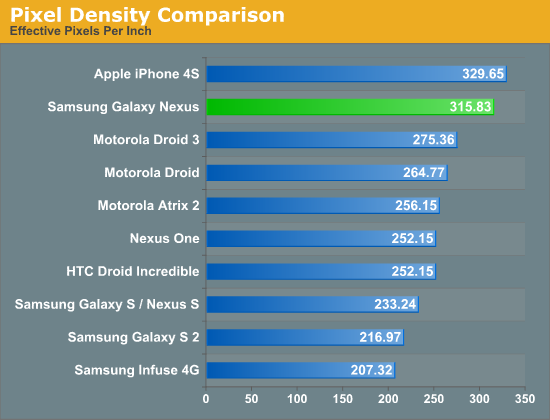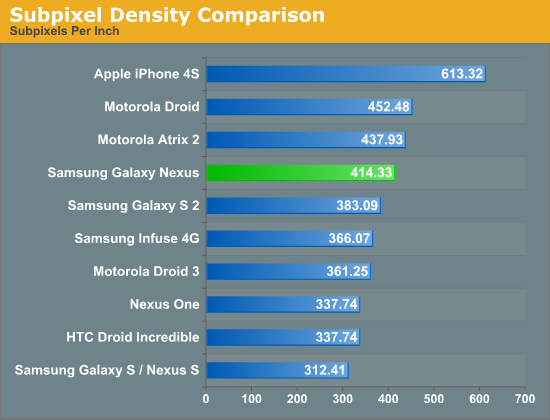Confirmed: Galaxy Nexus Includes PenTile
by Brian Klug & Jason Inofuentes on October 21, 2011 12:58 AM EST- Posted in
- Smartphones
- Samsung
- Ice Cream Sandwich
- Mobile
- AMOLED
- galaxy nexus
Though we've learned a lot about the Galaxy Nexus specifications already, one of the things that has remained a question thus far is whether its 4.65" 720p HD Super AMOLED display uses an RGB subpixel rendering layout or PenTile. We've now confirmed that the Galaxy Nexus display does in fact use RGBG PenTile, like all the Nexus devices to date. This isn't super surprising considering that Samsung has been pretty good about adhering to all the monikers it has gradually been tacking onto AMOLED. There are a number so far - 'super' connotes an optically bonded panel and digitizer stack, 'plus' connotes an RGB stripe, and now 'HD' connotes, well, 720p. HD Super AMOLED lacks Plus, and thus isn't an RGB stripe.
The next question is just what 4.65" HD Super AMOLED will look like, or whether the presence of PenTile will be as noticeable as previous AMOLED phones like the Nexus S / Galaxy S or Nexus One where it was arguably very noticeable. That said, at some subpixel density it should become difficult to impossible to notice PenTile's presence, it's just a matter of exceeding human visual acuity. Having not seen the Galaxy Nexus in person yet and given the absence of good macro shots of the display, we have put together a numerical comparison pitting the Galaxy Nexus panel up against some other common smartphone displays.
First up is a quick plot of the effective pixel density of some popular displays. Stated another way, this is the pixel density based on the manufacturer's stated logical resolution, which is also the resolution of Android's render target for the phone.

Note that this is the traditional means of reporting pixels per inch that we've published before. However, using this metric is just a bit misleading since it doesn't take into account the difference between 2 subpixel-per-pixel RGBG or RBGW PenTile versus the 3 subpixel-per-pixel RGB stripe. To make for an effective comparison, we've put together another plot where we take into account the presence of PenTile and report subpixel density.

Here things still look pretty good for the 4.65" HD Super AMOLED display, putting it just north of SGS2's Super AMOLED Plus display with an RGB stripe. I wager that if you were satisfied with the pixel density of SGS2 that the pixel density Galaxy Nexus actually won't be off-putting despite the presence of PenTile. In addition, hopefully some of the UI design considerations that come along with using PenTile (no vertical 1 pixel thick elements) have been taken into consideration from the outset for Ice Cream Sandwich. For true subjective impressions however, we'll have to wait and see.
Source: Data










152 Comments
View All Comments
ajp_anton - Friday, October 21, 2011 - link
What would be a better way?You basically have these choises:
1. Worst case scenario, assume the orientation is along the shorter side.
2. Best case scenario, assume the orientation is along the longer side.
3. No orientation, evenly distributed.
4. Other kinds of "averages" of 1 and 2 (e.g geometric or arithmetic means)
Benefits of #3:
- It is the only one that is unaffected by the screen ratio and how you cut it. It is constant and well defined for every size and shape of the same panel.
- You only need one single element (pixel) to determine the density, you only have to know what kind of panel is used, not its size.
- You don't have to know the subpixel orientation. In the future it might even become diagonal (two triangular subpixels per pixel, or something else in RGB pixels), in which case #3 is the only one that still works without modification.
- If subpixel density becomes a popular marketing number in the future, #3 is the only one that can't be cheated by orienting the pixels in a way that has no benefit, but gives a bigger value.
JesusR - Friday, October 21, 2011 - link
I always see the iPhone as the one with more pixel density, but how about the LG LU6200, with 720×1280 in 4.3" (i.e. 342 ppi)? Or the several Sharp phones with 327 ppi? Or even the Toshiba Portege G900, with 313 ppi in 3'', whcih was anounced in February 2007, 3 years before Apple presented its Retina Display? I think there are several phones with similar pixel density.Chinpokomon - Friday, October 21, 2011 - link
Using the same calculations in the article for effective pixel density, I got the same answers in the first graph (updated to 3.54" for the 4S).I then calculated the actual pixel density rather than subpixels, and got:
iPhone 4S - 325.93
Galaxy Nexus - 293.99
Nexus One - 232.87
Galaxy S II - 218.49
Galaxy/Nexus S - 215.41
This uses a (2/3) scaler for the horizontal pixel resolution, thereby ignoring that we no longer have square pixels in the calculation. I then calculated the actual diagonal resolution and found the actual PPI. Too me, this is a better way to compare both the effective and actual PPI of these different displays.
The "Retina display" display as explained by Chris Brandrick in this (http://www.pcworld.com/article/198201/iphone_4s_re... PC World article, is a display that is approximately 300 ppi or better from 12" away.
Arguably this makes the display on the Galaxy Nexus a "Retina display", or just shy of it. I love my Nexus S display, so this is going be a nice improvement.
Chinpokomon - Friday, October 21, 2011 - link
Interestingly, I added JesusR's LG LU6200 to the mix, and found even more reason to disbelieve the SPPI calculations as valuable.For the LG LU6200, I got 341.54 calculated PPI, 341.54 Actual PPI, and 583.90 Actual SPPI. My Actual SPPI calculations match the ones from the Subpixel Density Comparison chart, so I believe I've calculated SPPI the same way. That said, as calculated PPI for the iPhone 4S is 325.93 and 341.536 for the LU6200, how is the SPPI 606.39 for the 4S and 583.90 for the U6200?
As others suggested earlier, I think aspect ratio is a factor here, but when calculating the Actual PPI as I did above, the results give a better representation.
shimman - Friday, October 21, 2011 - link
Brian Klug & Jason Inofuentes appear to be biased against Samsung (or not so smart)First, subpixel density comparison chart
what's up with RGBW LCD being better than RGB based screens?
Second, most of people who did hands on Galaxy Nexus were impressed with the quality of the screen.
Pentile can create sharper image at same sub-pixel counts than the RGB arrangement
sub-pixel counts: Galaxy Nexus = iphone4S.
this means 4.6" Galaxy Nexus > 4.6" with iphone4S resolution.
If you don't like pentile OLED Super AMOLED HD screen, alternative is LCD screens which will ave grey black, ghosting, low contrast, narrower viewing angle, and less vivid color.
To me Super AMOLED HD is the best screen for the mobile phone for now.
Jussi7 - Saturday, October 22, 2011 - link
I do not see a bias against Samsung. I do see a big gaping hole in your logic.If you don't like Pentile OLED, you might try non-pentile OLED first. OLED and Pentile are not a match made in heaven, as shown in Samsung's Super AMOLED Plus screens which were mentioned in the article.
For example, I have seen Galaxy S (Pentile) and Galaxy S2 (RGB) phones in person. The first screen is way worse (fuzzy, patterns) than the second. The PPI of the first is higher than PPI of second, ergo comparing only PPI between RGBG and RGB and pixel layouts is not solid.
schriss - Saturday, October 22, 2011 - link
I own Galaxy S II and I have preordered Galaxy Nexus for it's higher resolution screen. I have now mixed feelings, like I was cheated with fake HD screen, that might have more pixels but they will be fuzzy. What's the point then? If I see more content on that HD screen but it will be fuzzy I will have to zoom in to see same amount of details I see in Galaxy S II?That would be huge disappointment, I hope Samsung would never risk releasing a disappointing display and I hope they did use Galaxy S II display as main comparison for the new display and they wouldn't release something that's not an improvement.
Maybe they will have HD Super Amoled Plus ready for Galaxy S III?
Filiprino - Saturday, October 22, 2011 - link
You can bet on it.
barnie - Saturday, October 22, 2011 - link
The reason is simple: Pythagoras' theorem does not work if you are using different measures of distance in the two axes. You're pretending to be measuring a diagonal, but the triangle you are forming to do that has none of the characteristics of the one that actually contains it.The simplest realistic approximation involves calculating the area of subpixels and taking a square root to give you a linear measure. It boils down to a sqrt(2/3) factor, or PenTile being <19% worse than RGB in linear subpixels per inch.
warmongerd - Saturday, October 22, 2011 - link
Wasnt Brian Klug the guy posting the really biased benchmarks between iPhone 4s and GsII not so long ago?